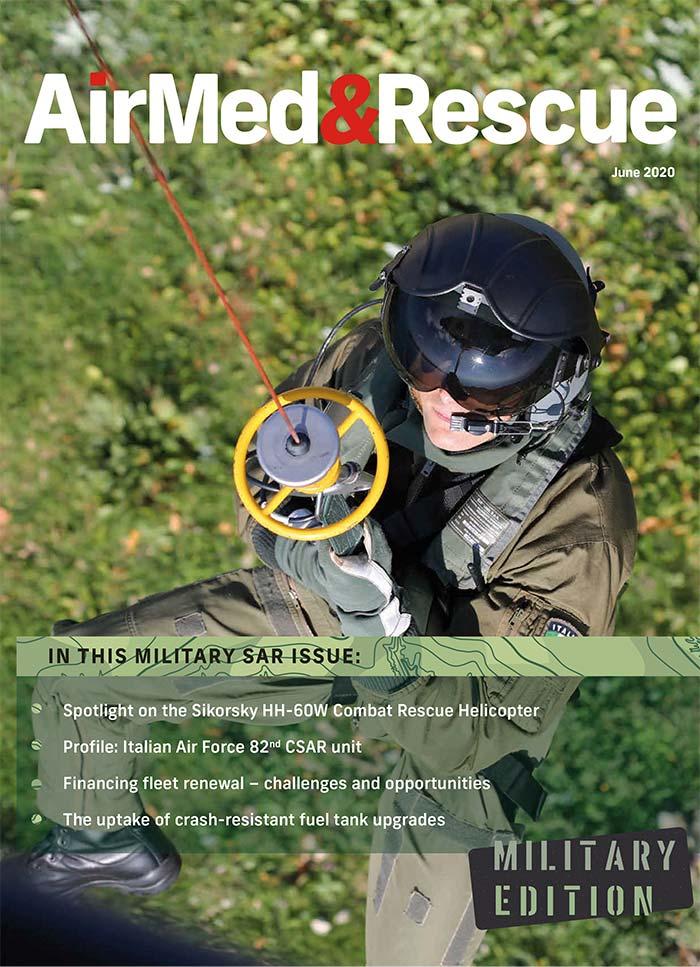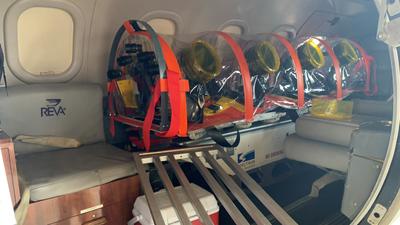Case Study: PIU repatriation of fully ventilated patient

Dr Liam Scott of Capital Air Ambulance reports on how the team dealt with a life-threatening emergency during an isolation repatriation mission to the UK from Turkey
Patient
A UK citizen in his 70s was admitted to hospital in Turkey with symptoms suggestive of a large stroke. According to the limited information available, he had presented with a hemiparesis and a reduced conscious level. A CT head scan showed multiple cerebral infarcts, so he was started on anticoagulation medication and transferred to a ward for rehabilitation. Several days into his admission, he was started on antibiotics for a presumed chest infection. Two days later, he was found to be in cardiorespiratory arrest; resuscitation commenced, and circulation was restored after approximately 20 minutes. He was intubated and transferred to an intensive care unit (ICU) on vasopressor support, where preparations were made to repatriate him back to the UK. Given the worsening international Covid-19 crisis, he was tested for coronavirus twice; both tests were reported as negative. At this point, Capital Air Ambulance became involved in his case.
Mission
There were several important logistical elements to consider. Despite the negative Covid-19 tests, the transfer was undertaken during the rapidly escalating coronavirus pandemic. Any respiratory deterioration in a critically unwell patient was therefore considered to be potentially viral in origin.
Capital had recently acquired a Portable Isolation Unit (PIU) for the transfer of suspected Covid-19 patients, and this would be the first repatriation of a fully ventilated patient using this system
Capital had recently acquired a Portable Isolation Unit (PIU) for the transfer of suspected Covid-19 patients, and this would be the first repatriation of a fully ventilated patient using this system. The PIU is a sealed, zip-locked, transparent, negative pressure, stretcher-mounted pod with internal and external air filters. There are several access ports for ventilator tubing, monitoring wires and flush lines, as well as integrated gloves to allow procedures to be performed inside the pod. The medical team included a critical care doctor, a paramedic and a senior flight nurse (who would also act as the mission manager). It was planned as a single-day mission using one of Capital’s LearJet 45s, with a tarmac transfer at the airport in Turkey. Given the additional equipment and staffing required, a fuel stop in Greece was planned for the return sector.
After arriving in Turkey, specific zones of the tarmac adjacent to the aircraft were designated for donning and doffing personal protective equipment (PPE), and preparing the medical equipment. In order to prevent unnecessary contamination of the kit or aircraft, one of the medical crew remained ‘clean’ in order to pass equipment or medications to the crewmembers, who were busy assessing the patient in the ground ambulance.
Accurate assessment
During the initial assessment, the patient was found to be intubated but not sedated, was being hand ventilated with a self-inflating bag, had only one peripheral cannula in-situ, and had only pulse-oximetry for monitoring. The team set about establishing peripheral venous and invasive arterial access, full ICU monitoring, sedation, paralysis and mechanical ventilation. After commencing the Oxylog ventilator, there were frequent high-pressure alarms. Bilateral lung air entry sounded poor and wheezy throughout, so nebulized salbutamol was administered. Closed endotracheal suctioning, tube repositioning and ventilator adjustments helped to some extent, but the airway pressures remained significantly elevated. With little else correctable to find at that time, the patient was transferred into the PIU and loaded aboard the aircraft.

A critical condition
During the first sector from Turkey to Greece (approximate flight time of 90 minutes), the ventilator pressures remained very high, despite re-dosing the muscle relaxants and sedation. His blood pressure became increasingly difficult to maintain, despite an ongoing peripheral metaraminol infusion; the team therefore bolused dilute adrenaline and fluids intermittently as a temporising measure. Given the increasing difficulties managing ventilation, a very low blood pressure and increasing tachycardia during the final approach into Greece, the decision was made that during the fuel stop, the PIU would be opened to facilitate a full reassessment and emergency management.
His blood pressure became increasingly difficult to maintain, despite an ongoing peripheral metaraminol infusion
After landing, the pilots were asked to promptly exit the aircraft and move any ground team clear; the medical team remained inside and quickly donned their PPE. On auscultation, there was now reduced air entry on one side of the chest, despite withdrawing the endotracheal tube and closed suctioning. With these findings in the setting of a peri-arrest patient, the flight doctor suspected a tension pneumothorax and performed an immediate cannula decompression [mid-clavicular line, second intercostal space]. A loud hiss of escaping air was heard, and an immediate improvement in the patient’s cardiovascular parameters and reduction of ventilatory pressures was observed. The needle decompression was then followed by a surgical ‘finger’ thoracostomy [mid-axillary line, fifth intercostal space].
Following these life-saving procedures, the patient’s condition remained relatively stable for the remainder of the transfer. A peripheral adrenaline infusion was continued to support his blood pressure; the ventilation became manageable with sedation and paralysis; antibiotics were given; and calcium chloride, insulin and intravenous fluids were administered as required, guided by bedside blood gas analysis. After a challenging seven-hour journey, the patient was handed over to the receiving UK team late at night in a stable condition.

Looking back
It was a high-intensity transfer, with multiple competing clinical and non-clinical considerations. Success in the management of a life-threatening emergency during a logistically challenging repatriation required excellent teamwork and communication; a thorough pre-flight assessment, anticipation and stabilization; and the ability to respond quickly and effectively to a dynamic situation in a remote environment. The decision to open the PIU was not taken lightly. Before the flight, the team had agreed that the patient most likely represented a low clinical risk of transmitting Covid-19, and he remained intubated with a closed, filtered ventilator circuit throughout. On balance, it was felt that with appropriate precautions (waiting until the aircraft had stopped and the pilots had exited; wearing PPE), the immediate threat to life justified opening the pod in order to intervene.
Some details have been changed to preserve patient confidentiality.

June 2020
Issue
In this Military Edition:
- Feature: HH-60 Combat Rescue Helicopter
- Military SAR, a look ahead
- Provider Profile – Italian Air Force
- Crash-resistant fuel tank uptake
- Lease or buy - renewing air medical fleets
- First-pass success in pre-hospital intubation
- Case Study: PIU repatriation of fully ventilated patient
Dr Liam Scott
Dr Liam Scott is a senior registrar in Anaesthesia and Intensive Care, working full time in Bristol, UK. His clinical interests include patient transfer and focused echocardiography. For the last three years he has worked part time as a critical care Flight Doctor for Capital Air Ambulance, undertaking national and international fixed-wing transfers in KingAir 200s and LearJet 45s.

